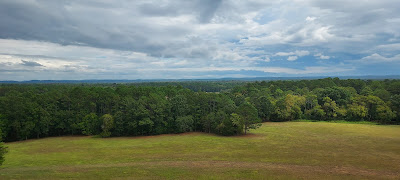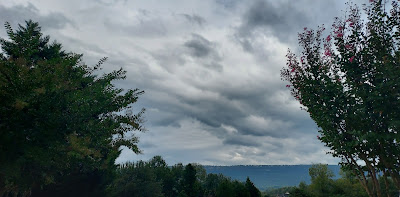We had what we consider a very long driving day (7 hours portal to portal) from Moorhead, Kentucky because we deleted an overnight stop from our itinerary to avoid any run-ins with Hurricane Francine. So, we did not arrive until late afternoon at Raccoon Mountain Caverns and Campground in Chattanooga, Tennessee. This RV Park has friendly, efficient staff, extra-long pull-through sites, scenic vistas, playground, pool, and clean laundromat. Of course, this came at the hefty price of $76/night (this includes an extra $6 for exceeding 2 vehicles/site, even though the Jeep fit on our site with room to spare)!
Over the course of our stay, we took in the local sights:
- the Tennessee Valley Authority (TVA) Raccoon Mountain Pumped Storage Hydroelectric Plant (which produces 1650+ megawatts of electricity!);
- the Chattanooga Choo Choo Hotel and Historic Site (which, in my humble stuffed rat opinion, was a giant nothing burger);
- Ross’s Landing along the Tennessee River. It's Plaza is where an emotional and heartfelt art exhibit, “The Passage”, depicts the Trail of Tears, the tragic forced removal of 16,000 Cherokees and other Indian Nations from their homelands by the U.S. government under President Andrew Jackson in 1838. Jackson’s refusal to honor the ruling of the Supreme Court that the Indians had sovereign rights to their homelands and his continuing with the Indian Removal Act is considered by many as ethnic genocide, with thousands of Indians perishing along the routes.
We also explored the shops in Downtown Chattanooga and the
vendors who were participating in a Fall Festival.
 |
| I'm gonna slay a dragon--no dungeon for me! |
We went to the Moccasin Bend Archeological site, thinking we were going to see some cool cultural lands. Instead, we found ourselves at the front gate of a mental health facility that sits on the designated site. Afraid my parents might get us all committed, I hightailed it out of there. I reunited with my parents at the head of the Blue Blaze Trail, which we all hiked together, despite the rain showers that followed us.
We went back over to Georgia to visit the home of John Ross, Principal Chief of the
Cherokees from 1828-1866. He fought
vigorously yet unsuccessfully against the removal of the Indians/taking of
their lands. The house was built in 1797
and was used during the Civil War as a hospital.
We headed to Chickamauga and Chattanooga National Military
Park. As we watched the film, perused
the exhibits, took the auto tours, and hiked the trails, we imagined ourselves
at Chickamauga Creek in Fort Oglethorpe, Georgia, just a few miles south of
Chattanooga, Tennessee. Chattanooga was
a major supply hub and strategic gateway for the South. As such, gaining control of the City was an
important mission for the Union.
 |
| The acorn adorned many Union monuments, symbolizing being steadfast and sturdy like an oak tree. |
 |
| Reconstructed cabin of the Brotherton family. Fighting took place on their lands. |
 |
| This monument, known as Wilder Tower, is dedicated to the Union's Army of the Cumberland Lightning Brigade, led by John Wilder. |
 |
| Awesome views... |
 |
| ...from the top of the Tower. |
So where does Chickamauga Creek fit into this tale? It is here that Confederate General Braxton Bragg had retreated from Chattanooga in early September 1863 after being outmaneuvered by Union General Rosecrans at Lookout Mountain. It is here that General Bragg obtained reinforcements. It is here that a heavy battle transpired at Snodgrass Hill, Horseshoe Ridge, and LaFayette Road. And it is here that General Bragg was successful in breaching a gap in the Union army’s line, forcing Union General Rosecrans to retreat to Chattanooga.
Now General Bragg, back in the driver’s seat, began a siege
of the city of Chattanooga, hoping to cut off supplies for the enemy and force
the Union into submission. But that was
not to be. You see, President Lincoln
had fired General Rosecrans, subsequently naming General Grant “the Big
Kahuna.” Grant brought Union
reinforcements (who traveled 1,300 miles in just 11 days!) and opened a
Union supply line at Chattanooga called “Cracker” (after their ration
staple), thereby ending the siege.
Battle ensued from November 23-25, 1863 with Union successes at Orchard
Knob, Lookout Mountain, and Missionary Ridge, placing control of Chattanooga
squarely in the hands of the Union.
We attended a ranger program at Point Park to learn more
about the aforementioned battle at Lookout Mountain. With primarily hand-to-hand combat fought on
the slopes of mountains and enveloped in fog, it earned the moniker “Battle
Above the Clouds”. True to its name, Lookout
Mountain offers fantastic views of the Tennessee River and Moccasin Bend.

We paid our respects at the National Cemetery, whose grounds include the area where the Battle of Orchard Knob was fought.
We also popped in to the Confederate Cemetery.
And we visited Missionary Ridge, though it contains very little evidence of the battle that carries its name. We hiked a portion of the Bluff Trail and stopped at the Craven House, once the Confederate Headquarters. As seen at countless sites we have visited these last few months, this is another historical building closed to the public.
Though not the end of our touring season, this was the last Civil War battlefield of the 26 on our travel itinerary.
 |
| A Junior Ranger Badge achieved at the Chickamauga and Chattanooga Military Park! |
This leads yours truly, Rambling RV Rat, to some final thoughts:
Undeniably, slavery was and is wrong. But, despite the narrative often being told,
the Civil War was NOT just about slavery.
The real issue was States’ rights and overreach of the Federal
government that started decades earlier than the onset of the Civil War. Sadly, Federal overreach continues to this day. The Constitution gives the Federal government
limited powers. Everything not
specifically enumerated within the Constitution falls under States’ rights.
Furthermore, the hypocrisy of the North stupefied me. For example, Lincoln’s Emancipation
Proclamation specifically freed the slaves in the “Rebel” states. Yet, it did not address slaves within the
Union states, of which there were plenty.
Worried that his Proclamation could be challenged as unconstitutional,
Lincoln pushed for Congress to enact legislation. The 13th amendment of the
Constitution to abolish slavery was introduced in February 1864. It was ratified by the required 27 (of 36)
states by December 6, 1865, including most of those that were part of the
Confederacy previously. Yet 2 Union
States—New Jersey and Delaware—refused to ratify it initially and were among
the final 5 states to do so. In fact,
Delaware did not ratify it until 1901!
Speaking of New Jersey, it was the only free state east of the
Mississippi River whose electorates voted against Lincoln in the 1860 election,
despite his platform of abolishing slavery.
And Maryland, although it remained part of the Union, was a slave-holding
state.
President Lincoln’s desire for immediate results created a
revolving door of leadership for the Union.
Meanwhile, the Confederates had consistency with General Lee and his
main sidekicks, Jackson, and Longstreet—at least until Jackson’s demise in 1863
and Longstreet’s injury in 1864. Despite a reliable leadership team, the South
had a consistent 2-1 manpower disadvantage compared to the Union (and in
some battles, the Union had 3 to 4 times as many troops as the Confederates). Would the outcome of the war have been
different if the army sizes were the same?
What if Lee accepted Lincoln’s initial offer to make him
Commander of the Potomac rather than pledging allegiance to his home state of
Virginia when it joined the Confederacy?
Would the war have ended sooner, giving Lincoln the victory he so wanted
and needed?
After touring so many battlefields, I now wonder how many
landscaping and topographical features we see today were formed through trench
warfare. What looks like a small hill
could represent a byproduct of war.
How fortunate we are that people corresponded and chronicled
through the written word (so unlike life today). They articulated so eloquently their hopes
and fears. Their journals skillfully detailed
their surroundings, the conditions they encountered, and the tactical and
strategic logistics of warfare. Though
they have long left this earth, their recounting of history remains. Immersed now in a digital world with nearly
all correspondence and documentation conducted electronically and so easy to delete permanently, what
will remain to recount our history 100 years from now?
Our Civil War battlefield tour has been an enlightening yet emotional lesson in history. My heart
aches for the plight of the slaves and the horrendous conditions they
endured. I am horrified at the number of
casualties resulting from this war, those who were injured temporarily, those who were maimed permanently, and those who gave the ultimate sacrifice for their convictions and beliefs. I pray
our Nation and world realize the senselessness of war. In the end, no one emerges as a winner. War, what is it good for—ABSOLUTELY NOTHING!




































No comments:
Post a Comment